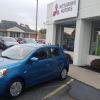There are 3 ways to charge a Bolt:
- Level 1...............120V...about 4 miles per hour of charge
- Level 2...............240V/32 Amp...up to 25 miles per hour of charge
- DC Fast Charge...up to 55 kW...about 100 miles in 30 minutes of charging
Level 1 is plugging the car into a normal household outlet. It's the
slowest way to charge an EV.
Level 2 requires a 240 Volt power source. These are the "free" charging stations you see in your local shopping centers, hotels, etc. You can also install an aftermarket 240V charger in your garage.
DC Fast Charging stations are what you use to put a lot of charge into the battery in a short period of time. Instead of filling your tank with gas in 7 minutes, you plug your Bolt into a DC Fast Charger for an hour or so while you grab something to eat.
But wait...there's more.

As an EV battery's state of charge goes up, the charging rate gradually goes
down. So a Bolt can charge fairly quickly from 0% to say 75%. But the last 25% is going to be at a much slower rate. From what I can tell, most people on long road-trips don't stop and charge the battery up to 100% every time unless they really need that extra bit of range. It's faster to charge up to 75-80% and just get rolling to the next charging station.
More expensive EVs can DC fast charge at a faster rate than the Bolt. A Tesla Model 3 can charge up to 80% in something like 30 minutes using a Tesla supercharger.


 2002 Mitsubishi Delica Space Gear L400
2002 Mitsubishi Delica Space Gear L400
 Reply With Quote
Reply With Quote My Mirage
My Mirage


 Scoot
Scoot
 Blueberry
Blueberry